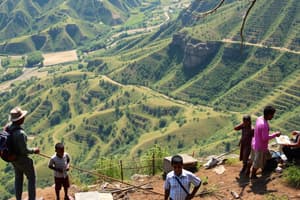Podcast
Questions and Answers
What is the primary function of GPS technology?
What is the primary function of GPS technology?
- To collect and transmit data from connected devices.
- To capture images and measurements from a distance using various tools.
- To analyze and visualize geographic data as digital maps.
- To provide location data by tracking movement using satellites. (correct)
Which geospatial technology is best described as a computer system for geographic data?
Which geospatial technology is best described as a computer system for geographic data?
- Remote Sensing
- GIS (correct)
- Telematics
- GPS
Remote sensing involves which of the following methods?
Remote sensing involves which of the following methods?
- Capturing data from a distance using satellites, airplanes, or cameras. (correct)
- Using a computer to analyze geographic information.
- Tracking movement through satellites.
- Sharing data collected from devices over a network.
Telematics can best be defined as what?
Telematics can best be defined as what?
Which application is NOT a direct example of the use of GIS technology?
Which application is NOT a direct example of the use of GIS technology?
What do patterns primarily represent in geographic studies?
What do patterns primarily represent in geographic studies?
How are trends best illustrated in geographical studies?
How are trends best illustrated in geographical studies?
What aspect separates patterns from trends in geography?
What aspect separates patterns from trends in geography?
Which statement accurately describes spatial significance?
Which statement accurately describes spatial significance?
What is a primary consequence of human activity on nature as mentioned?
What is a primary consequence of human activity on nature as mentioned?
Which of the following correctly identifies a characteristic of maps compared to graphs?
Which of the following correctly identifies a characteristic of maps compared to graphs?
In the context of geographical thinking, why is it necessary to explore four steps of spatial significance?
In the context of geographical thinking, why is it necessary to explore four steps of spatial significance?
Which term accurately describes how features can be arranged on a map?
Which term accurately describes how features can be arranged on a map?
Which of the following best describes geography's role in problem-solving?
Which of the following best describes geography's role in problem-solving?
What do patterns in geography typically illustrate?
What do patterns in geography typically illustrate?
Which of the following perspectives in geography focuses on the effects of decisions made by governments?
Which of the following perspectives in geography focuses on the effects of decisions made by governments?
What is a defining characteristic of trends in geographic studies?
What is a defining characteristic of trends in geographic studies?
Which statement differentiates facts from opinions in geographical perspectives?
Which statement differentiates facts from opinions in geographical perspectives?
Why is geographical thinking important in understanding global issues?
Why is geographical thinking important in understanding global issues?
Which example best illustrates a pattern in geographic data?
Which example best illustrates a pattern in geographic data?
How do spatial and temporal changes relate to geographic thinking?
How do spatial and temporal changes relate to geographic thinking?
Flashcards are hidden until you start studying
Study Notes
Geography is a Tool
- Geography is more than a subject, it's a tool for understanding the world.
- It can be used in fields like:
- Studying animal populations
- Tracking diseases
- Planning business locations
- Geography helps solve problems by examining human-environment interactions.
Geographical Thinking: Perspectives
- Geographical perspectives are shaped by facts and opinions.
- Key perspectives include:
- Social: Impact on people
- Environmental: Impact on nature
- Political: Government decisions
- Economic: Jobs and money
- Facts are proven truths backed by data, research, or scientific studies.
- Opinions are personal views, not always based on facts.
Geographical Thinking: Patterns and Trends
- Patterns show how things are arranged in a geographic area.
- Often displayed on maps.
- Can be clustered, dispersed, or linear.
- Trends represent changes over time.
- Typically displayed through graphs.
- Example: The rise in electric car sales.
- To study patterns and trends:
- Observe data
- Describe using geographic vocabulary
- Hypothesize reasons for the patterns/trends
Geographical Thinking: Interrelationships
- Interrelationships are relations between two or more patterns or trends.
- They highlight how humans and nature impact each other.
- Example: Pollution influenced by human activity.
Geographical Thinking: Spatial Significance
- Spatial Significance is the importance of a particular location.
- It involves understanding:
- Where a place is (absolute location)
- Its natural and human features
- How the location impacts people and the planet.
- Steps to determine spatial significance:
- Identify the location of the event (absolute and relative location)
- Identify natural aspects (landscape, resources, conditions, processes)
- Identify human aspects (human activities, infrastructure, impacts)
- Explain why it is important (human and natural impacts)
Geographical Thinking: Geospatial Technologies
- Main types of geospatial technologies:
- GPS (Global Positioning System): Satellite network providing location data.
- GIS (Geographic Information System): Computer system for storing, analyzing, and visualizing geographic information as digital maps.
- Remote Sensing: Seeing or measuring something from a distance using satellites, airplanes, cameras, radar, or lidar.
- Telematics: Technology sharing data from connected devices, creating a network of devices that communicate with each other.
- Geospatial technologies are used to generate information into maps and applications.
Geographical Thinking: Understanding Geographical Data
- Requires critical thinking and analysis.
- Involves recognizing spatial patterns and trends.
- Understanding the influence of human and natural factors.
- Applying geographic perspectives to data interpretation.
- Essential for solving real-world problems related to resource management, environmental protection, and sustainable development.
Studying That Suits You
Use AI to generate personalized quizzes and flashcards to suit your learning preferences.




